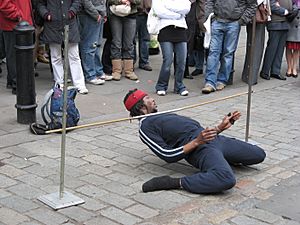Limbo (dance) facts for kids
Limbo is a fun and challenging dance contest. It started a long time ago on the island of Trinidad. People believe it began as a special event at wakes, which are gatherings after someone has passed away.
A famous dancer named Julia Edwards helped make limbo very popular. She was known as the "First Lady of Limbo." Her dance company traveled all over the world in the 1960s. They even appeared in movies like Fire Down Below (1957). A film called Julia and Joyce (2010) also tells the story of how Julia Edwards made limbo so famous.
Contents
How to Play Limbo
Playing limbo is simple but tricky! You need a horizontal bar, often called the limbo bar. This bar is placed on top of two vertical poles.
- Each person tries to go under the bar.
- You must bend backward, with your back facing the floor.
- No part of your body is allowed to touch the bar.
- Only your feet can touch the ground. If you touch the bar or fall, you are out!
- After everyone has had a turn, the bar is lowered a little bit.
- The game continues until only one person can successfully go under the bar without touching it. That person is the winner!
Limbo's Journey to Popularity

Long ago, traditional limbo started with the bar very low. It was slowly raised, which symbolized coming from death into life. But when limbo became entertainment, dance groups started doing it the other way around. They began with the bar higher and lowered it.
Julia Edwards added exciting new parts to limbo performances. She used human "bars" made from other dancers' bodies. She also added fire to make the shows even more amazing! Limbo dancers often move to special Afro-Caribbean drum beats.
As limbo grew popular, pop music started using Caribbean rhythms. This helped the dance become a craze in the United States. A great example is the song "Limbo Rock" by Chubby Checker. This song became a huge hit and helped popularize the famous question: "How low can you go?" Another artist, Brigo (Samuel Abrahams), a Calypsonian from Trinidad, also helped bring limbo into the mainstream with his song "Limbo Break."
Limbo is unofficially known as the national dance of Trinidad and Tobago. This country is proud to be known as the land of limbo, steelpan (steel drums), and calypso music.
Limbo Around the World
Limbo spread from Trinidad and Tobago to other places. In islands like Barbados and Jamaica, limbo became a big part of tourism. Many dance groups still perform limbo today. You can see it during the Carnival season in Trinidad and Tobago.
When professional limbo dancers perform, they often invite people from the audience to join in. This makes limbo very popular because everyone can try it! At many resorts in tropical places, limbo dancing is used as a fun "icebreaker" game for tourists. The person who wins often gets a prize.
The word "limbo" comes from the English language spoken in Trinidad. It is thought to be related to the word "limber," which means flexible or easy to bend.
Limbo History and Meaning
The word "limbo" became common in the 1950s. Some people believe the dance shows the whole cycle of life. Dancers go under a pole that gets lower and lower. When their heads clear the pole, it can symbolize life winning over death. This dance was also sometimes used at funerals.
Limbo dancing dates back to the mid-to-late 1800s in Trinidad. It became widely popular in the 1950s.
World Record Holder
The world record for the lowest limbo dance belongs to Shemika Charles. She is a woman from Trinidad who lives in Buffalo, NY. On September 16, 2010, she successfully danced under a bar that was only 8.5 inches (21.5 cm) above the ground! That's super low!
See also
 In Spanish: Limbo (juego) para niños
In Spanish: Limbo (juego) para niños




